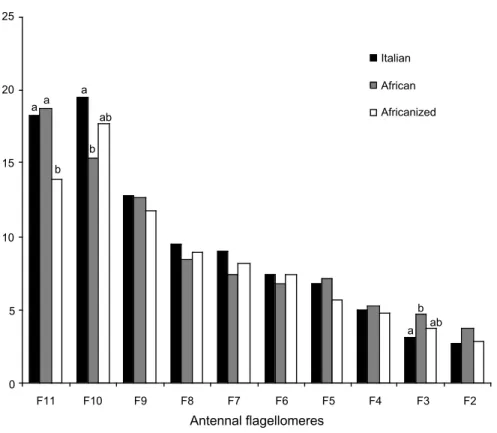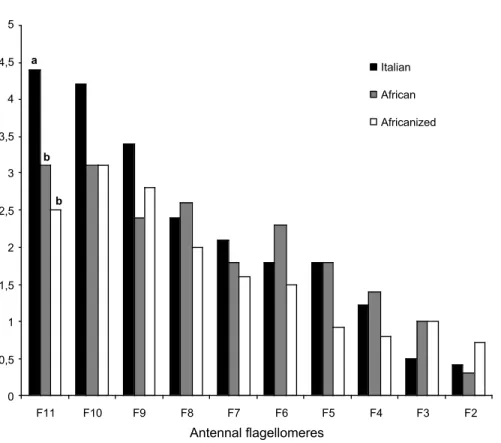DIFFERENCES IN THE NUMBER OF ANTENNAL SENSORY
STRUCTURES OF MALES OF THREE HONEY BEE TYPES
STORT, A. C.1 and MORAES-ALVES, M. M. B.2
1Department of Biology, Biosciences Institute, CEP 13506-900, Rio Claro, SP, Brazil 2Department of Exact and Biological Sciences, University Center of Dourados, UFMS,
CEP 79825-070, Dourados, MS, Brazil
Correspondence to: Antonio Carlos Stort, 1Department of Biology,
Biosciences Institute, CEP 13506-900, Rio Claro, SP, Brazil
Received October 17, 1997 – Accepted May 04, 1998 – Distributed February 23, 1999
(With 3 figures)
ABSTRACT
The number of sensilla campaniformia and sensilla coeloconica + sensilla ampullacea of flagellomeres 2 to 11 of the antennae of three types of males (Italian, African and Africanized) was determined by scanning electron microscopy. Comparison of the three male types showed that Italian males did not differ from African males in number of sensilla coeloconica + sensilla ampullacea and that both dif-fered from Africanized males in terms of flagellomere 11. With respect to flagellomeres 3 and 10, Italian males were similar to Africanized males and both differed from African males. No differences between the three male types were detected in the other flagellomeres. In relation to the number of sensilla campa-niformia Italian males differed of the African and Africanized males with respect to flagellomere 11.
Key words: antennae, flagellomeres, sensilla, Apis mellifera.
RESUMO
Diferenças no número de estruturas sensoriais antenares de machos de 3 tipos de abelhas melíferas
O número de sensilla campaniformia e sensilla coeloconica + sensilla ampullacea dos flagelômeros 2 ao 11 das antenas de 3 tipos de machos (italianos, africanos e africanizados) foi estudado através do microscópio eletrônico de varredura. As comparações dos 3 tipos de machos mostraram que, em relação ao número de sensilla coeloconica + ampullacea, os italianos não diferiram dos africanos e ambos eram diferentes dos africanizados em termos do flagelômero 11. Em relação aos flagelômeros 3 e 10, os italianos eram semelhantes aos africanizados e ambos diferiram dos africanos. Nos outros flagelômeros não foram verificadas diferenças entre os três tipos de machos. Em relação ao número de sensilla campaniformia, os italianos diferiram dos africanos e dos africanizados quanto ao fla-gelômero 11.
Palavras-chave: antenas, flagelômeros, sensilla, Apis mellifera.
INTRODUCTION
The Africanized bees of Brazil, which origi-nated from crosses of African bees (Apis mellifera scutellata) with European bees (Italian, Apis mellifera ligustica, and German, Apis mellifera mellifera), have been studied in terms of the most diverse aspects such as defensive behavior (Stort, 1971), flight activity (Kerr et al., 1970),
size (Moraes, 1988) and size of the cuticular depressions of the antennal flagellomeres (Dietz, 1978).
However, little is still known about the antennal sensory structures of Africanized bees, especially in males and in comparison to the typical African and European subspecies that gave ori-gin to them. The objective of the present investi-gation was to determine the differences in number of sensilla campaniformia and sensilla coeloconica + sensilla ampullacea in males of three types of honeybees: African (Apis mellifera scutellata), Italian (Apis mellifera ligustica) and Africanized.
MATERIAL AND METHODS
The samples used in the present study were 10 adult males from colonies of African honey bees (Apis mellifera scutellata) collected from the Kosmos apiaries in Pretoria (South Africa), 10 adult males from Italian honey bee colonies (Apis mellifera ligustica) originating from queens im-ported from the United States, and 10 adult males from colonies of Africanized honey bees main-tained in the apiaries of the Biosciences Institute of UNESP, Rio Claro. The specimens were col-lected live, anesthetized and killed in an ether chamber and then fixed in modified Karnovsky (2% glutaraldehyde and 2% paraformaldehyde in 0.1 M phosphate buffer, pH 7.2) for 24 hours. The samples were then transferred to and stored in 70% alcohol. The antennae were removed from the head, submitted to ultrasound for 1 minute to remove dirt particles, then glued to metal supports, sputtered with a fine gold layer using an Edwards S150-B sputter and observed with the scanning elec-tron microscope (JEOL, model T330-A) of the Chemistry Institute, UNESP, Araraquara. The numbers of sensilla campaniformia and sensilla coeloconica + sensilla ampullacea were counted in the cuticular depressions (Fig. 1) of antennal flagellomeres 2 to 11. Flagellomere 11 is the most distal one and flagellomere 1 does not have these structures. The data obtained were first
submit-RESULTS AND DISCUSSION
The mean counts of sensilla coeloconica + sensilla ampullacea per antennal flagellomere in the three male types studied are illustrated in Fig. 2. Only flagellomeres 3, 10 and 11 presented significant F values when the data were submitted to analysis of variance. The Tukey test showed that only African and Italian males did not differ in terms of flagellomere 11. In contrast, only African and Italian males differed from one another in terms of flagellomeres 3 and 10. It has been reported that the number of antennal sensilla placodea and sensilla trichodea of workers is larger in Italian than in Africanized bees (Stort, 1978; Stort & Barelli, 1981) and that the number of sensilla coeloconica and sensilla ampullacea is larger in Caucasian than in Africanized bees (Stort & Malaspina, 1997). It was also observed that the number of antennal sensilla placodea and sensilla trichodea is larger in Italian and German workers than in African workers (Stort, 1979).
The present data show that this is not the case for males. In contrast to workers, the number of sensilla coeloconica + sensilla ampullacea on flagellomere 11 is identical in African and Italian males and lower in Africanized males. In flagellomeres 3 and 10, the number of these sensilla is identical in Italian and Africanized males and lower in African males.
niformia than African and Africanized males and also showed that the latter two did not differ from each other. In this case the data obtained for males agree with those obtained for workers.
Apis mellifera males have a larger number of sensilla placodea (olfactory disks) than workers (7.36 times more). This must confer a very high olfactory sensitivity on them, which they use to be able to find the queen during the mating flight. However, workers and males have similar numbers of sensilla campaniformia and sensilla coeloconi-ca + sensilla ampullacea. Since sensilla coeloconicoeloconi-ca
variations in these factors in the environment. Thus, it appears that the degree of environmental hu-midity and temperature is secondary for the males (in relation to smell sense) in the process of finding a queen and mating.
Acknowledgments: Research supported by CNPq and FAPESP. The authors are grateful to Dr. José Arana Varela, Chemistry Institute, UNESP, Araraquara, for permitting the use of the scanning electron microscope, to Dr. Mario Cilense and to Mr. Sebastião Dameto, of the same Institute, for help during the use of the equipment.
a a
a a
b
b b
ab
ab
0 5 10 15 20 25
F11 F10 F9 F8 F7 F6 F5 F4 F3 F2
Antennal flagellomeres
Italian
African
Africanized
a
b
b
0 0,5 1 1,5 2 2,5 3 3,5 4 4,5 5
F11 F10 F9 F8 F7 F6 F5 F4 F3 F2
Antennal flagellomeres
Italian
African
Africanized
Fig. 3— Mean number of sensilla campaniformia per antennal flagellomere in 3 types of honey bee males. An equal let-ter for two males types means that they are not different.
REFERENCES
BEIG, D., PISANI, J. F. & KERR, W. E., 1972, Capacidade estomacal das abelhas operárias de duas subespécies de
Apis mellifera L. (Hymenoptera, Apoidea). Cienc. Cult. 24(5): 464-468.
CARVALHO, M. A. S., 1982, Morfometria comparada em zangões e análise do número de cerdas das asas de ope-rárias de Apis mellifera. Master’s dissertation, UNESP, Rio Claro, 107p.
COSENZA, G. W. & BATISTA, J. S., 1972, Morfometria da Apis mellifera adansonii (abelha africanizada), da
Apis melliferacaucasica (abelha caucasiana) e suas hí-bridas. An. 2º Congr. Brasil. Apic., Sete Lagoas, 53-56. DALY, H.V. & BALLING, S. S., 1978, Identification of Africanized honey bees in the Western Hemisphere by discriminate analysis. J. Kans. Entomol. Soc., 51: 857-869. DIETZ, A., 1978, An anatomical character suitable for sepa-rating drone honey bees of Apis mellifera ligustica from
Apis mellifera adansonii. An. Simp. Int. Apic. Clim. Quen. Apimondia, 102-106.
DIETZ, A. & HUMPHREYS, W. J., 1971, Scanning elec-tron microscopic studies of antennal receptors of the worker honey bee, including sensilla campaniformia.
GONÇALVES, L. S., 1969, A study of orientation informa-tion given by one trained bee by dancing. J. Apic. Res. 88(3): 113-132.
GONÇALVES, L. S., 1970, Análise genética do cruzamento entre
Apis mellifera ligustica e Apis mellifera adansonii. Escolha e análise genética de caracteres morfológicos da cabeça e do tórax. Ph.D. thesis, USP, Ribeirão Preto, Brazil, 142p. KERR, W. E., GONÇALVES, L., BLOTA, L. F. & MACIEL,
H., 1970, Biologia comparada entre as abelhas italianas (Apis mellifera ligustica), africanas (Apis mellifera adansonii) e suas híbridas. An. 1º Congr. Brasil. Apic. Florianópolis, 151-185.
KUWABARA, M. & TAKEDA, K., 1956, On the hygroreceptor of the honey bee Apis mellifera. Physiol. Ecol., 7: 1-6. MALASPINA, O. & STORT, A. C., 1987, Sucrose syrup –
collecting behavior in Africanized and Caucasian bees and in the descendants of their crossings. Rev. Brasil. Genet., 10(3): 459-469.
MARTINHO, M. R., 1979, Competição reprodutiva entre machos de Apis mellifera e migração de espermatozóides para a espermateca de rainhas. Ph.D. thesis, F.M.R.P.; USP, 111p.
REBUSTINI, M. E., 1995, Estudo do comportamento defensivo e da estrutura do ferrão em abelhas africanizadas e européias. Ph.D. thesis, UNESP, Rio Claro, 80p.
STORT, A. C., 1971, Estudo genético da agressividade de
Apis mellifera. Ph.D. thesis, F.F.C.L., Araraquara, 166p. STORT, A. C., 1978, Comportamento agressivo e estruturas sensoriais em abelhas africanizadas e italianas. An. Simp. Intern. Apic. Clim. Quen., Apimondia, 53-55. STORT, A. C., 1979, Estudo genético de caracteres
morfológicos e suas relações com o comportamento de defesa de abelhas do gênero Apis. Livre-docência the-sis UNESP, Rio Claro, 179p.
STORT, A. C. & MALASPINA, O., 1980, Comparação do número de estruturas sensoriais em machos de duas subespécies de Apis mellifera. Dusenia, 12(2):51-56.
STORT, A. C. & MALASPINA, O., 1997, Differences in the number of sensilla coeloconica and sensilla ampullacea of segment 10 of the antennae of Africanized and Cau-casian bees and of their F1 hybrids. Braz. J. Genet., 20(2): 189-192.
STORT, A. C. & MORAES-ALVES, M. M. B., 1998, A study of the sensory structures of the antennae of
Scaptotrigona postica workers (Hymenoptera – Apidae).
Rev. Brasil. Biol., 58(1): 163-167.


